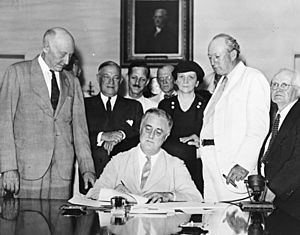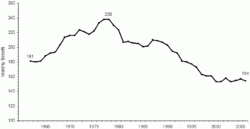Welfare reform facts for kids
Welfare reform is about changing how a government helps people who need support. It aims to make these programs work better and be fair for everyone – both those who receive help and those who pay taxes.
The main goals of welfare reform are:
- Helping people become more independent and able to support themselves.
- Making sure welfare programs can keep running in the future.
- Sharing resources fairly among people.
People often debate welfare reform because it's tricky to balance helping people with encouraging them to be self-sufficient.
Contents
What is Welfare Reform?
Since the 1970s, countries around the world have looked closely at their welfare systems. Changes in population, like fewer babies being born and more older people, combined with economic problems, meant that more people needed help from welfare systems. This made countries think about how to reform them.
For example:
- The United States focused on helping single parents find jobs so they wouldn't need welfare as much.
- The United Kingdom tried to reduce unemployment through a program called the New Deal.
- The Netherlands worked on changing programs for people with disabilities.
- Countries in Latin America mainly focused on reforming pension systems (money for retired people).
Different Views on Welfare Reform
People have different ideas about welfare reform:
- Some, like classical liberals, libertarians, and conservatives, believe that welfare can make people less likely to work. They think it can also lead to a "free-rider problem," where some people benefit without contributing.
- Others, like social democrats and socialists, often worry that welfare reforms might cut too much from the public safety net. They believe this could make life harder for those in need and strengthen the capitalist system too much.
A Look Back at Welfare History
Many experts say modern welfare started in Germany in the late 1800s. German Chancellor Otto von Bismarck introduced health insurance laws in 1883. This was the first time a government made health insurance required for everyone. It also included retirement and disability benefits.
In the United States, the Great Depression in the 1930s caused many people to lose their jobs and savings. To help, President Franklin D. Roosevelt started programs like Aid to Families with Dependent Children and the Social Security Program through the Social Security Act. These programs created a public welfare system to help people in need, and they have grown into the system we have today.
United States Welfare Changes
In 1964, President Lyndon B. Johnson launched the "War on Poverty" because many Americans were still living in poverty. This plan funded programs like Food Stamps, Job Corps, and Head Start. It also created Medicare (health insurance for seniors) and Medicaid (health insurance for low-income people).
Later, President Richard Nixon suggested the 1969 Family Assistance Plan. This plan would have required most welfare recipients to work, except mothers with very young children. This idea caused a lot of debate and was eventually removed. Even so, it started more discussions about how the welfare system should work.
In 1981, President Ronald Reagan cut funding for some welfare programs. He also allowed states to require welfare recipients to join "workfare" programs, where they had to work to receive benefits. A book called Losing Ground by Charles Murray (1984) argued that welfare actually hurt poor families by making them too dependent on the government.
In his 1992 campaign, President Bill Clinton promised to "end welfare as we have come to know it." This led to the Personal Responsibility and Work Opportunity Act (PRWORA) in 1996. This law changed welfare a lot. Before, poor families had a right to federal aid through a program called AFDC. The new law, PRWORA, ended AFDC and replaced it with Temporary Assistance for Needy Families (TANF). This meant that being poor no longer automatically gave someone a legal right to federal aid.
One reason for these changes was that more women were working outside the home by the 1990s. This led to an expectation that women receiving welfare should also work.
United Kingdom Welfare Changes
New Deal
In 1997, the Labour government introduced the New Deal program. Its goal was to help more people find jobs by requiring welfare recipients to actively look for work.
Welfare Reform Act 2007
The Welfare Reform Act 2007 aimed to help more people find jobs. It wanted to increase the number of people working and reduce the number of people claiming certain benefits.
Welfare Reform Act 2009
This law focused on increasing personal responsibility. It changed how some benefits were given out to encourage employment and updated child support laws.
Welfare Reform Act 2012
This act changed Housing Benefit, which helps people pay for their homes. It reduced the benefit for people living in homes larger than their family needed. The media often called this the "Bedroom Tax." The goal was to reduce how much people depended on welfare.
France Welfare Changes
Starting in the mid-1970s, France's social insurance program began to have money problems. This led the government to cut back on welfare spending. By the end of the 1990s, they had mostly fixed the problem. In 2020, France also made big changes to its pension system.
Brazil Welfare Changes
During an economic crisis in Brazil (2015–2018), there was a lot of political and economic trouble. President Dilma Rousseff wanted to expand a social welfare program called Bolsa Família. However, when President Michel Temer took over, he suggested welfare reforms to save money. His plan included limiting pension benefits and raising the retirement age. This led to protests across Brazil.
India Welfare Changes
India has made many changes to its welfare system, especially in the last five years. These include:
- Direct Benefit Transfers (DBT): Sending money directly to people's bank accounts.
- Ayushman Bharat: A health insurance scheme.
- PM-Kisan: Income support for farmers.
India’s Banks Nationalised
In 1969, Prime Minister Indira Gandhi decided to take control of 14 of India's largest private banks. This meant the government now controlled most of the banking system. The main goal was to make sure banks helped achieve India's socialist goals after gaining independence. Before this, banks were not lending enough money to important areas like agriculture and small businesses.
Pradhan Mantri Jan Dhan Yojana (PMJDY)
In 2014, Prime Minister Narendra Modi launched this program. It aims to give every Indian household a bank account, insurance, and overdraft facilities. The idea is to make it easier for the government to send money directly to people and improve the welfare system.
Technology and Welfare in India
Over the last ten years, technology has become very important in India's welfare reforms. Systems like Aadhar (a national ID document) and DBT (direct benefit transfers) are used to send funds. In 2014, only 28 programs used DBT, but by 2019, over 400 did.
While technology helps reduce corruption and make payments more efficient, it also has challenges. Sometimes, people don't receive payments even if records show they did. This can happen because people don't know how the system works, or there are errors. It's important to find a balance between using technology for efficiency and making sure the system is easy for people to use and understand.
Canada Welfare Changes
In 1945, Prime Minister William Lyon Mackenzie King introduced a plan to focus on full employment and high income, mainly by helping private businesses.
Between 1951 and 1952, Prime Minister Louis St. Laurent made several key changes:
- He amended the Indian Act to allow Indigenous people to apply for provincial social welfare for the first time. This meant they could receive cash benefits. However, this change also gave provinces more power over Indigenous children, leading to a sad period where many Indigenous children were moved from their homes.
- He also introduced universal old-age pensions for Canadians over 70.
In the 1960s, Canada introduced three important laws for its modern welfare state:
- In 1964, the National Housing Act was changed to help provinces build public housing.
- In 1965, the Canada Pension Plan was created, which is a required pension plan for workers.
- In 1966, the Canada Assistance Plan combined different assistance programs and helped fund a national healthcare system.
In 1971, Prime Minister Pierre Elliott Trudeau expanded Unemployment Insurance, making it available to almost everyone who temporarily lost their job. He also used the tax system to give Canadian families a child tax credit for the first time in 1978.
The 1970s saw economic problems in Canada, which led to a new political approach that wanted to reduce government spending on social programs. This period saw the start of a decline in some parts of the Canadian welfare state.
In the 1980s and 1990s, some welfare programs were cut. This led to more food banks and emergency shelters being needed because there wasn't enough government help.
In 1995, Prime Minister Jean Chrétien ended the Canada Assistance Plan. It was replaced by the Canada Health and Social Transfer, which gave money to provinces for healthcare, education, and social services. Many provinces then started "workfare" policies, pushing people on welfare to find jobs.
More recently, Prime Minister Stephen Harper introduced the Universal Child Care Benefit in 2006, giving families money for each child under six. In 2022, Prime Minister Justin Trudeau finalized an agreement to create a Canada-wide system for affordable childcare.
Netherlands Welfare Changes
In 2023, the Future Pensions Act came into effect, updating the Dutch pension system.
See also
- Austerity
- Self-Sufficiency Project
- Social reform
- Welfare dependency
- Workfare



